Yellow is such a joyous colour in the garden, there is no end to the plant partnerships that can be made with it. I once heard someone say that they don't want any yellow flowers in their garden beds. My immediate thought was of how much they are missing.
Yellow hues can range from pale creamy-yellow to bright lemony-yellow, or cover all the variations between. They all have perfect partnering colours, to either complement them or provide contrast to them. You need only refer to the numerous combinations below for more ideas to spark your imagination.
* Watch for the animated hummingbird and butterfly with the plants that attract them. *
The deer icon indicates plants that deer are not usually attracted to.
   The best time and method to propagate plants can be found on our image-intensive PROPAGATION page.
To help your plants grow their best, check out our FERTILIZATION page.
To create your own plant partnerships based on tried and true color theory, check out our GARDEN COLOR page.
To see if a particular plant is on this page press Ctrl+F, type in the name, then click the Find button.
The best time and method to propagate plants can be found on our image-intensive PROPAGATION page.
To help your plants grow their best, check out our FERTILIZATION page.
To create your own plant partnerships based on tried and true color theory, check out our GARDEN COLOR page.
To see if a particular plant is on this page press Ctrl+F, type in the name, then click the Find button.
INULA
There are many species and cultivars available in this genus belonging to the Daisy family, ranging from a 2" dwarf to a 6 foot giant with many garden-worthy forms in heights in between. Most prefer full sun and well-drained soil.
Inula ensifolia: Swordleaf Inula, 12"x12"
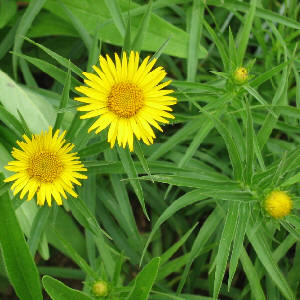
If you only know the 6-foot-tall forms of Inula you'll be surprised by the different effect created by this short-statured form
Inula royleana: Himalayan Elecampane
with: white Astilbe, silver-foliage plants i.e. Artemisia, pale blue Japanese Iris
IRIS
 There are many yellow Iris to choose from, from the shortest early-blooming dwarf to the later-blooming tall bearded forms. Shades of yellow can range from pale and creamy to bright and brassy. They will all perform best if given full sun.
There are many yellow Iris to choose from, from the shortest early-blooming dwarf to the later-blooming tall bearded forms. Shades of yellow can range from pale and creamy to bright and brassy. They will all perform best if given full sun.
Iris: unidentified form

I can't wait until this beautiful plant is ready for division and forms a large patch
Iris x germanica: Bearded Iris, yellow
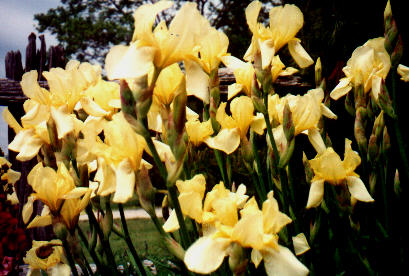
with: Anchusa azurea, Hosta sieboldiana 'Elegans'
Iris x germanica: Bearded Iris, medium height yellow
behind: Sedum spurium 'Dragon's Blood'
beside: Veronica
Iris x germanica: Bearded Iris, yellow Intermediate
with: Tulipa 'Dillenburg' & Viola 'Arkwright Ruby' edging, in front of Allium aflatunense
Iris x germanica: Bearded Iris, lemon-yellow Intermediate
with: Veronica whitleyi (a blue, early-spring bloomer)
Iris x germanica: Bearded Iris, light yellow
with: Phlox paniculata (a white form), Sedum spurium 'Dragon's Blood', Veronica
Iris x germanica: Bearded Iris, yellow and cream
combined with: Veronica teucrium 'Shirley Blue' & Paeonia (single white)
Iris x germanica: Bearded Iris, cream
with: Papaver orientale (to tone it down)
Iris x germanica: Bearded Iris, cream or yellow Intermediate
with: Endymion hispanicus (Scilla campanulata)
Iris x germanica: Bearded Iris, pale yellow dwarf form
with: Veronica pectinata 'Rosea'
Iris 'New Moon': Bearded Iris, lemon-yellow, 36"
with: deep purple co-bloomers
combined with: deep purple Iris ('Dusky Challenger'), pure white Iris ('Ermine Robe')
Iris pseudacorus: Yellow Flag Iris, 40", bluish foliage
where: in constantly moist to boggy soil; standing water
with: Paeonia, Lilium, annual Papaver
with other moisture-loving Iris: I. versicolor or I. fulva
with: large-leaved plants for contrast i.e. Petasites japonicus var. giganteus
Iris pumila: yellow dwarf
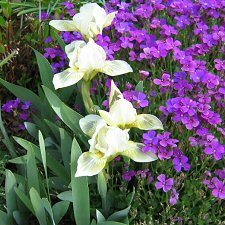
seen in the photograph above with purple Aubrieta deltoidea
behind: Sedum spurium 'Dragon's Blood'
Learn how and where to grow many forms of Iris and what companions to plant with them at the links below.
blue Iris
bulbous Iris
Iris as edgers
orange Iris
purple Iris
red Iris
white Iris
Iris with variegated foliage
KNIPHOFIA
 We usually think of the colour orange in relation to the Torchlily, Poker Plant or Red-Hot Poker as it is variously known. Most show yellow when flowers open from the bottom up for a two-toned effect. And there are even some that are completely yellow.
We usually think of the colour orange in relation to the Torchlily, Poker Plant or Red-Hot Poker as it is variously known. Most show yellow when flowers open from the bottom up for a two-toned effect. And there are even some that are completely yellow.
Kniphofia x pfitzeri: deep orange
Kniphofia uvaria: Common Torch Lily, yellow & orange
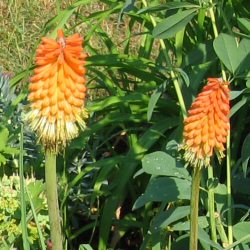
with: a dark purple Delphinium, yellow Hemerocallis
with: Ornamental Grasses, Artemisia, Oenothera
If you still like the colour orange in your garden, learn what companions to plant with this perennial to bring out its best.
orange Torch Lily
LAMIASTRUM
Yellow Archangel is perfect when you want a yellow-flowered perennial that will carpet a stretch of ground in part shade. Too aggressive for most borders, it will add a variegated effect with its foliage after blooms have finished. Extra plants can be used as a cascading edger in planters where the variegated foliage can be appreciated up close.
Lamiastrum galeobdolon 'Luteum': False Lamium, Yellow Archangel, 12-18"x20"
now: Galeobdolon luteum
foliage: silver-spotted
flowers: flowers in whorls along trailing 6-8" stems
where: groundcover in shade, including dry shade, in containers, in woodland gardens
with: spring bulbs, early wildflowers, ferns
Lamiastrum galeobdolon 'Herman's Pride': metallic silver foliage, 8" tall
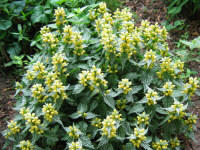
where: excellent as edger in shade
note: this cultivar spreads much slower and keeps a more rounded shape than the plant directly below
Lamiastrum galeobdolon 'Variegatum'

image above: lovely variegated foliage perfect in planter pot with annual Petunias
Lamiastrum galeobdolon 'Variegatum'
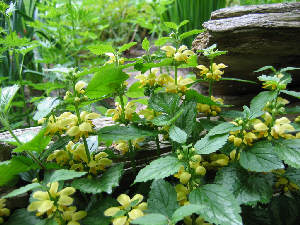
synonym: Lamiastrum galeobdolon 'Florentinum'
note: the foliage lies flat against the ground until just before bloom time, then flattens out again after bloom has finished
where: groundcover in difficult shady areas (including under trees), covering a rocky slope
with: spring bulbs, early wildflowers, ferns on moist sites
Lamiastrum grows well in shade and has different foliage choices as you will see if you follow the links below.
Archangel in shade
Archangel with variegated foliage
LILIUM
Yellow is only one of the many colours that inspire us to add plants from this wonderful family of flowers to our gardens. Whether your Lily choices are Asiatics, Orientals, Trumpets, Aurelian Hybrids or the multiple species available, you can have blooms over a long period from early to late. Experiment to find co-bloomers for your own forms or choose from the suggestions below.
Lilium: yellow
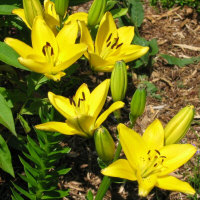
with: blue Lobelia, Gypsophila, Campanula lactiflora
over: Viola, Linum, Campanula carpatica (which can act as a living mulch), Dianthus, Geranium
Lilium martagon: Martagon Lily, Turk's Cap Lily, lemon-yellow, 3-5'x2'
with: Lythrum virgatum, Gypsophila paniculata & Stachys byzantina
Unlimited ideas about using Lilies and what other plants to put with them are available at the links below. Let the recommendations of gardening experts inspire you in designing the garden you want.
orange Lilies
pink Lilies
red Lilies
white Lilies
LINUM
Mention perennial Flax and most gardeners will immediately think of the colour blue. But there is a clear yellow form with feathery, narrowly oval, green foliage, perfect in a frontal position in full sun which it prefers to part shade. Give it well-drained, dry, light soil so it will grow well and soon you will have a new favourite in this family of perennials.
Linum flavum: Flax, Golden Flax, 12"x15"
where: edger, rock gardens
with: deep-blue or purple flowers i.e. Salvia, Lobelia siphilitica
Want more blue or white in your beds? Follow the links below for more ideas.
blue Flax
white Flax
LYSIMACHIA
The name Loosestrife needn't strike fear in the hearts of gardeners. Unlike Purple Loosestrife which belongs to an entirely different genus called Lythrum, the perennials in the genus Lysimachia are better behaved and pose no threat to our wetlands. You can safely choose from the yellow forms below.
Lysimachia: Loosestrife
with: Iris sibirica, Ligularia dentata or stenocephala, Filipendula, Hosta, ferns
Lysimachia ciliata 'Atropurpurea': Fringed Loosestrife, 24-36"x24"
synonym: Steironema ciliata
where: borders, woodland gardens
use for: good contrast between yellow flowers and purple-bronze foliage, attracts butterflies
Lysimachia nummularia 'Aurea': Creeping Jenny, 2-4"x18", bright golden leaves
where: shady sites (to avoid scorching)
between: different fern species
under: Pulmonaria (blue)
Lysimachia punctata: Yellow Loosestrife, 36-40"x18-24"
where: borders, woodland gardens, waterside
with: scarlet Papaver orientale, navy Anchusa, white or blue Iris x germanica or Iris sibirica
behind: Salvia x superba
Try the links below for more information and ideas.
Loosestrife for shade
white Loosestrife
Loosestrife with variegated foliage
OENOTHERA
 Sundrops are showy perennials, sometimes referred to as Evening Primrose, since flowers open in the late afternoon or evening. Blooms are saucer-shaped with 4 overlapping petals. These may spread faster than you'd like when you provide the full sun and adequate drainage that they thrive in. The correct pronunciation for this genus is ee-no-THEER-ruh.
Oenothera fruticosa: Sundrops
Sundrops are showy perennials, sometimes referred to as Evening Primrose, since flowers open in the late afternoon or evening. Blooms are saucer-shaped with 4 overlapping petals. These may spread faster than you'd like when you provide the full sun and adequate drainage that they thrive in. The correct pronunciation for this genus is ee-no-THEER-ruh.
Oenothera fruticosa: Sundrops
where: hot, dry sites in full sun & lean soil
with other summer-blooming perennials: Campanula glomerata 'Superba',
Nepeta x faassenii, Iris,
Scabiosa x 'Butterfly Blue (Beauty)', Hemerocallis, Achillea, Lavandula, Yucca
Oenothera macrocarpa: Ozark Sundrops
Oenothera macrocarpa 'Green Court': sulphur yellow
formerly: Oenothera missouriensis 'Green Court'
with: Heuchera 'Palace Purple'
Oenothera tetragona: Yellow Sundrops, red buds open to lemon-yellow flowers
formerly: Oenothera fruticosa youngii
Oenothera tetragona 'Youngii':
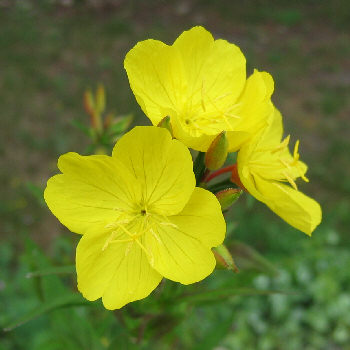
appearance: similar to spreading Oenothera fruticosa but stays in a neat clump
with: scarlet Lychnis chalcedonica, Hemerocallis (any colour), Eryngium, Tiger Lily
with: Tradescantia virginiana (blue or white), Nepeta x faassenii, Iris
Sundrops can be found on other pages of this site by following the links below.
Sundrops as edgers
pink Sundrops
PAEONIA
 Yellow may be a more common colour in Tree Peony forms, although there are some yellows among Garden Peonies such as the one below.
Paeonia lactiflora 'Primavera': yellow & white, 20-24"x30", highly fragrant
Yellow may be a more common colour in Tree Peony forms, although there are some yellows among Garden Peonies such as the one below.
Paeonia lactiflora 'Primavera': yellow & white, 20-24"x30", highly fragrant
with: minor bulbs
with: Myosotis
with early-summer perennials: Iris sibirica, Digitalis
Gardening experts grow lots of Peonies in their gardens. The links below will tell you what plant partnerships have worked for them. Try some of the ideas yourself.
pink Peonies
red Peonies
white Peonies
The two links below are informative with lots of additional links to numerous Peony sites. Please bookmark us before you leave so you can find your way back soon.
PATRINIA
A genus of perennials forming neat clumps and grown for their flowers, they prefer partial shade and moist soil. Foliage is bold, a dark emerald green and fiddle-shaped. Small flower buds appear in clusters in July on slender, wiry stalks. In August, buds open to tiny, yellow flowers. Foliage remains green and flowers persist for 3-4 weeks, sometimes to the end of September. Not only is this a long-blooming late-bloomer, but it is also an excellent cut flower specimen. Because of its 3-4' height, this plant should be placed in a mid- to rear-border position. If you decide you like it, you will be pleased to find self-sown seedlings here and there around the mother plant. If you don't, your friends and neighbours would likely be happy to give this different yellow-flowered perennial a try.
Patrinia scabiosifolia:
with: Phlox paniculata, Echinacea purpurea, fall-blooming Anemone japonica (Anemone hupehensis)
Patrinia scabiosifolia 'Nagoya': bright yellow, late summer bloom, 3-6'x12"
with: any of the combinations above
with: tall Aster novae-angliae or Aster tataricus
wonderful with: Ornamental Grasses
combined with: Miscanthus sinensis 'Strictus' & Ilex verticillata 'Winter Red'
PRIMULA
 Primrose need consistent moisture, especially during their active spring growth. Mulch by way of chopped leaves or shredded bark will keep soil moist. Division is an easy form of propagation when you want to increase your favourite forms. Many completely yellow forms are available. Most colour forms have yellow centres.
Primula: soft yellows
Primrose need consistent moisture, especially during their active spring growth. Mulch by way of chopped leaves or shredded bark will keep soil moist. Division is an easy form of propagation when you want to increase your favourite forms. Many completely yellow forms are available. Most colour forms have yellow centres.
Primula: soft yellows
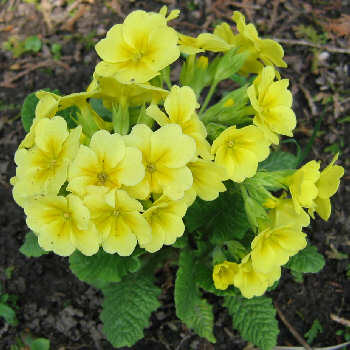
with: Phlox stolonifera
Primula 'Jaune': yellow with orange centres on stiff stems
with: Tulipa, Galanthus nivalis, Narcissus
Primula elatior: Oxlip Primrose, pale yellow
with: Narcissus (small types), Muscari (sky-blue)
If you have the right location for these shade-loving perennials in your garden, you might want to visit the link below for ideas on which ones to add to your plant shopping.
red Primroses
RANUNCULUS
 Ranunculus, Buttercup or Creeping Buttercup, at least the form hardy to Zone 3, is under two feet tall with shiny yellow flowers. There is even a double-flowered form. Best for rich, moist soil in full sun to light shade. Keep them out of formal gardens because of their rapid spread.
Ranunculus
More Ranunculus can be found at the link below.
Ranunculus in shade
Ranunculus, Buttercup or Creeping Buttercup, at least the form hardy to Zone 3, is under two feet tall with shiny yellow flowers. There is even a double-flowered form. Best for rich, moist soil in full sun to light shade. Keep them out of formal gardens because of their rapid spread.
Ranunculus
More Ranunculus can be found at the link below.
Ranunculus in shade
RUDBECKIA
 Mid to late summer would not be the same without all the bright cheerfulness of the Coneflowers. There are many forms to choose from, in a variety of sizes and colour combinations. All do best in full sun to light shade, with somewhat moist well-drained soil. Butterflies are not drawn to all forms in this genus.
Rudbeckia: Coneflower
Mid to late summer would not be the same without all the bright cheerfulness of the Coneflowers. There are many forms to choose from, in a variety of sizes and colour combinations. All do best in full sun to light shade, with somewhat moist well-drained soil. Butterflies are not drawn to all forms in this genus.
Rudbeckia: Coneflower
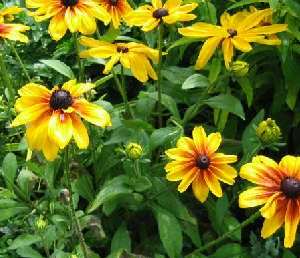
with: Echinacea purpurea, Perovskia atriplicifolia, Monarda spp, Sedum, Phlox paniculata
with native prairie grasses: Panicum virgatum, Andropogon scoparius, Sorghastrum nutans
with tall Ornamental Grasses: Miscanthus sinensis spp, Pennisetum alopecuroides
with: Hemerocallis, Achillea, Asclepias tuberosa,
Solidago, later- blooming forms of Coreopsis
with: Aster novae-angliae or Aster novi-belgii, Liatris
combined with: Phlox 'David' (white), Aster 'Hella Lacy' & Coreopsis 'Goldfink'
Rudbeckia fulgida speciosa 'Goldsturm': Orange Coneflower, the best of the Coneflowers
Rudbeckia 'Marmalade': golden-yellow with black centres
generally with : other summer blooming perennials
with : Echinacea purpurea, Perovskia atriplicifolia, Phlox paniculata, Sedum, Monarda spp,
Rudbeckia laciniata 'Goldquelle': Golden Fountain Coneflower, 32", an outstanding cut flower
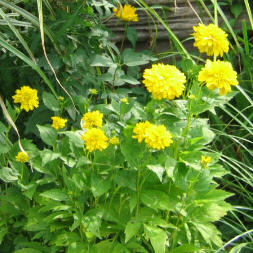
this is like a short version of the much-too-tall 'Golden Glow' cultivar
with : Achillea 'Gold Plate', Phlox paniculata (white), Echinops ritro, Heliopsis, Echinacea purpurea,
Perovskia atriplicifolia, Sedum, Monarda, tall Ornamental Grasses
Rudbeckia maxima: Giant Coneflower, Zone 6
with Ornamental Grasses: Miscanthus sinensis 'Morning Light'
Rudbeckia nitida 'Autumn Glory': 6'
combined with : Perovskia atriplicifolia & Solidago 'Peter Pan'
Rudbeckia nitida 'Golden Glow': 6'
combined with : Perovskia atriplicifolia & Solidago 'Peter Pan'
 Rudbeckia nitida 'Herbstsonne': Coneflower 'Autumn Sun', the Godzilla of the Coneflowers Rudbeckia nitida 'Herbstsonne': Coneflower 'Autumn Sun', the Godzilla of the Coneflowers
combined with: Perovskia x atriplicifolia & Solidago 'Peter Pan'
Get more ideas on using Coneflowers at the link that follows.
orange Coneflowers
SALVIA
  There are Sages in a variety of colours, including many purple-toned ones. Some are grown for their foliage while others are grown for the flowers. There is even a yellow-flowered form as you will see below. Provide well-drained soil in full sun. Sages are generally drought-tolerant once established.
Salvia glutinosa: pale yellow
There are Sages in a variety of colours, including many purple-toned ones. Some are grown for their foliage while others are grown for the flowers. There is even a yellow-flowered form as you will see below. Provide well-drained soil in full sun. Sages are generally drought-tolerant once established.
Salvia glutinosa: pale yellow
with: Geranium 'Ann Folkard'
More information and partnership ideas are available at the links below.
purple Salvias
white Salvias
Salvias to attract Hummingbirds
Salvias with silver foliage
Salvias with variegated foliage
SCABIOSA
 Pincushion Flower has many purple, blue and white forms. There is even a yellow-flowered species which, like the others in the genus, prefers well-drained, neutral to alkaline soil, as well as full sun to light shade.
Scabiosa ochroleuca: Yellow Scabious, pale creamy-yellow, 36"
Pincushion Flower has many purple, blue and white forms. There is even a yellow-flowered species which, like the others in the genus, prefers well-drained, neutral to alkaline soil, as well as full sun to light shade.
Scabiosa ochroleuca: Yellow Scabious, pale creamy-yellow, 36"
with : Knautia macedonica
This is one perennial you will want to add to your garden if you don't have it already. Follow the links below for more information on its use and its preferred partnership plants.
pink Pincushion Flower
white Pincushion Flower
SEDUM
While many of the taller Sedums, or Stonecrops, have pinkish-toned blooms, there are several shorter choices with tiny star-shaped yellow flowers and fleshy foliage. Give them full sun to light shade and well-drained soil for best results. Most are drought-tolerant once established. Only the Border Varieties in this genus are a draw for butterflies.
Sedum: unknown form; if you can identify this species, please let me know
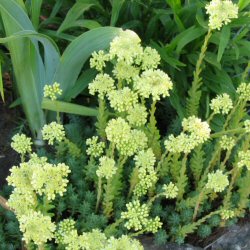
available in both pale yellow and bright yellow, this blooms at the ends of upright stalks, in July
with: mounding perennials, for perfect contrast to the upright stalks
soft yellow form with: soft blue or pale purple flowers
bright yellow form with: dark blue or purple flowers
Sedum kamtschaticum: Russian Stonecrop, Kamtschatka Stonecrop
combined with : Iris (for its strappy foliage) & Hemerocallis
Sedum kamtschaticum 'Variegatum': Variegated Russian Stonecrop
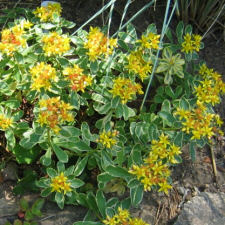
in front of : Kniphofia
Not sure where or how to use various forms of Stonecrop to best advantage? There's lots of information available at the links that follow.
many Sedums
Sedums as edgers
red Sedums
white Sedums
Sedums with silver foliage
Sedums with variegated foliage
SOLIDAGO
 Sometimes rather coarse perennials, the Goldenrods, especially the many available cultivars, add late summer yellow colour to the garden. Note that Goldenrod does not cause hay fever.
Solidago: Goldenrod
Sometimes rather coarse perennials, the Goldenrods, especially the many available cultivars, add late summer yellow colour to the garden. Note that Goldenrod does not cause hay fever.
Solidago: Goldenrod
where: prairie or meadow gardens, formal and informal border
with: Anemone hypehensis 'September Charm', Boltonia asteroides, Chelone lyonii, Chelone obliqua,
Garden Mums, Eryngium including E. amethystinum, Eupatorium coelestinum, Gentiana asclepidea, Helenium autumnale, Physostegia virginiana, Platycodon, Lavandula angustifolia, Liatris, Salvia, Ornamental Grasses
with other butterfly magnets: Asclepias tuberosa, Aster (especially blue or purple forms), Aster (Michaelmas Daisy),
Aster novi-belgii 'Benary's Composition Mix', Echinacea purpurea, Eupatorium coelestinum, Helianthus, Phlox paniculata, Rudbeckia, as a yellow echo with: Eriophyllum lanatum & Hemerocallis (a yellow co- bloomer)
Solidago canadensis: Canada Goldenrod
with : Echinacea, Rudbeckia, Platycodon grandiflorus, Liatris, Eupatorium coelestinum, Lavandula angustifolia,
Salvia, Aster (esp. blue or purple forms), Phlox, Helianthus, Liatris
with: Ornamental Grasses, Garden Mums
Solidago 'Golden Shower'
behind : Erigeron 'Prosperity' (a lavender-blue semi-double)
beside : Veronica (blue), Hosta fortunei 'Picta'
Solidago 'Peter Pan'
combined with : Rudbeckia nitida 'Autumn Glory', 'Golden Glow' or 'Autumn Sun' & Perovskia atriplicifolia
Solidago sphacelata 'Golden Fleece': golden (brilliant yellow)
where : massed as a groundcover
with: Iris x germanica
with : Crocus, Colchicum, Iris (for a spiky contrast)
Follow the link below for more information about Goldenrod.
siting Goldenrods
x SOLIDASTER
A cross between two different genera, Solidago and Aster, resulted in this summer-flowering perennial of a much softer yellow shade than its Goldenrod parent. It may therefore be much easier to blend into a garden in sun or shade in fertile soil where it will thrive.
x Solidaster luteus: Aster + Solidago
with : violet-blue flowered plants
with : Coreopsis verticillata
STYLOPHORUM
Celandine Poppy, or Wood Poppy, is a spring wildflower that grows best in evenly moist soil. Foliage is deeply lobed and long-lasting. The leaves and stems exude a yellow sap that was once used by Native Americans as a dye.
Stylophorum diphyllum: Celandine Poppy

note: this woodland plant can be seen in the border around this page, at the top of the page and directly above
with : Iris cristata, Phlox stolonifera
TANACETUM
 Common Tansy with aromatic, ferny, divided and somewhat glaucous foliage and golden-yellow flowers needs full sun for peak performance. Prevent self-seeding by removing spent flowers.
Tanacetum vulgare
Common Tansy with aromatic, ferny, divided and somewhat glaucous foliage and golden-yellow flowers needs full sun for peak performance. Prevent self-seeding by removing spent flowers.
Tanacetum vulgare
with: Achillea, Artemisia, Aster, Limonium latifolium, Salvia, Ornamental Grasses
THERMOPSIS
Spring-flowering Thermopsis, sometimes called False Lupine or Carolina Lupine, grows best in full sun and rich, somewhat acidic, soil. A stately 3-5 foot perennial it will grace the mid to rear sections of your borders. Lemon-yellow flowers appear atop upright stalks and gray-green foliage.
Thermopsis caroliniana: Carolina Lupine
synonym: Thermopsis villosa
where : rear border position; meadows; with shrubs; in lightly shaded gardens
generally with : rounded or mounding plants
with : Amsonia tabernaemontana, Campanula, Geranium, Paeonia
TROLLIUS
Globeflower grows in both sun and shade, provided that soil remains moist. It is available in a number of yellow or yellow-orange shades.
Trollius: Globeflower
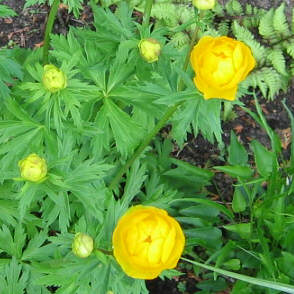
for a profile of this plant, follow the link to Trollius
where: near water's edge, in a moist site
generally with: any shade of blue or purple
with: Alchemilla mollis, Myosotis, Hosta, Primula, Ferns
with water-loving plants: Iris pseudacorus and other water-loving forms of Iris, Filipendula, Ligularia, Rodgersia
Trollius x cultorum 'Etna': warm yellow
The lovely globes of Globeflower add much charm to a garden in spring. Check out the link below for more information.
orange Globeflower
UVULARIA
A spring-blooming perennial for moist woodsy soil, Merrybells has long, drooping yellow blooms and foliage that continues to grow long after flowering has finished.
Uvularia grandiflora: Bellwort, Merrybells, Great Merrybells, 18-24"
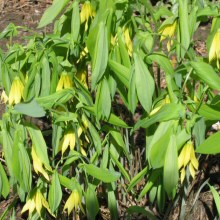
where: woodland gardens
with other shade lovers: Hosta, ferns, Tiarella cordifolia, Asarum, Sanguinaria canadensis, Dicentra eximia
Follow the link below for more ideas.
Merrybells in shade
VERBASCUM
 The Mulleins are summer-flowering perennials that thrive in full sun and very well-drained soil. Watch for self-sown seedlings.
Verbascum chaixii: Nettle-Leaved Mullein
The Mulleins are summer-flowering perennials that thrive in full sun and very well-drained soil. Watch for self-sown seedlings.
Verbascum chaixii: Nettle-Leaved Mullein
with: fine-textured perennials, mounded plants
with: Coreopsis verticillata, Geranium, Thalictrum, Nepeta, Geranium psylostemon, Ornamental Grasses
Verbascum olympicum:
with: Geranium 'Johnson's Blue'
Some of these plants are definitely worth adding to your garden. Check out those at the link below to see the possibilities.
Mulleins with silver foliage
white Mulleins
TO RETURN TO THE FIRST PAGE OF YELLOW PERENNIALS & THEIR COMPANIONS, FOLLOW THE LINK BELOW.
All of our own Gardens By The Bay pages can be accessed by clicking on the links below.
HOME
GARDEN POETRY |
GARDEN POETRY MUSE
GEORGIAN BAY VIEW
BOTANICAL LATIN - BASICS
COLOR THEORY
THE GARDENS
CORNER GARDEN CONSTRUCTION |
CORNER GARDEN PLANTING |
LONG GARDEN
EAST GARDEN |
HOSTA GARDEN |
NORTH GARDEN |
WINTER GARDENS
PLANT PARTNERSHIPS
BLUE PERENNIALS Aconitum -
Geranium |
Iris - Vinca
BULBS Allium - Hyacinthus |
Narcissus only |
Tulipa only |
Minor Bulbs
BUTTERFLY MAGNETS Anaphalis - Hemerocallis |
Liatris - Veronicastrum
 DAYLILIES Spider & Unusual Form DAYLILIES Spider & Unusual Form EDGERS Arabis - Iris |
Nepeta - Veronica
FOLIAGE PERENNIALS
Alchemilla - Tanacetum
HOSTA Hosta - all
HUMMINGBIRD-FRIENDLY PERENNIALS Alcea - Salvia
ORANGE PERENNIALS Achillea - Tulipa
ORNAMENTAL GRASSES Acorus - Imperata |
Miscanthus - Spodiopogon
PINK PERENNIALS Achillea - Lilium |
Lychnis - Veronica
PURPLE PERENNIALS Aconitum - Liatris |
Polemonium - Veronica
RED PERENNIALS Achillea - Veronica
SHADE PERENNIALS Aegopodium - Erythronium |
Ferns - Polemonium |
Polygonatum - Vinca
SILVER FOLIAGE PERENNIALS
Achillea - Cerastium
|
Cornus - Limonium
|
Lunaria - Veronica
SIMPLY SPECIAL PERENNIALS Acanthus - Saxifraga
WHITE PERENNIALS Achillea - Iris |
Kalimeris - Yucca
YELLOW PERENNIALS Achillea - Hypericum |
Inula - Verbascum
VARIEGATED-FOLIAGE PERENNIALS Acorus - Erythronium |
Hakonechloa - Lysimachia |
Miscanthus - Yucca
PLANT PROFILES
Dianthus 'Tiny Rubies' |
Geranium |
Geum coccineum |
Kerria japonica |
Knautia macedonica
Paeonia tenuifolia |
Papaver somniferum |
Rudbeckia |
Salvia 'East Friesland'
Trollius |
Veronica 'Sunny Border Blue'
PROPAGATION
DIVISION - SPRING ONLY |
DIVISION - FALL ONLY |
DIVISION - SPRING OR FALL |
DO NOT DIVIDE
FERTILIZATION
EDGERS Arabis - Iris |
Nepeta - Veronica
FOLIAGE PERENNIALS
Alchemilla - Tanacetum
HOSTA Hosta - all
HUMMINGBIRD-FRIENDLY PERENNIALS Alcea - Salvia
ORANGE PERENNIALS Achillea - Tulipa
ORNAMENTAL GRASSES Acorus - Imperata |
Miscanthus - Spodiopogon
PINK PERENNIALS Achillea - Lilium |
Lychnis - Veronica
PURPLE PERENNIALS Aconitum - Liatris |
Polemonium - Veronica
RED PERENNIALS Achillea - Veronica
SHADE PERENNIALS Aegopodium - Erythronium |
Ferns - Polemonium |
Polygonatum - Vinca
SILVER FOLIAGE PERENNIALS
Achillea - Cerastium
|
Cornus - Limonium
|
Lunaria - Veronica
SIMPLY SPECIAL PERENNIALS Acanthus - Saxifraga
WHITE PERENNIALS Achillea - Iris |
Kalimeris - Yucca
YELLOW PERENNIALS Achillea - Hypericum |
Inula - Verbascum
VARIEGATED-FOLIAGE PERENNIALS Acorus - Erythronium |
Hakonechloa - Lysimachia |
Miscanthus - Yucca
PLANT PROFILES
Dianthus 'Tiny Rubies' |
Geranium |
Geum coccineum |
Kerria japonica |
Knautia macedonica
Paeonia tenuifolia |
Papaver somniferum |
Rudbeckia |
Salvia 'East Friesland'
Trollius |
Veronica 'Sunny Border Blue'
PROPAGATION
DIVISION - SPRING ONLY |
DIVISION - FALL ONLY |
DIVISION - SPRING OR FALL |
DO NOT DIVIDE
FERTILIZATION
BULBS |
ORNAMENTAL GRASSES |
PERENNIALS |
SHRUBS |
VINES
LINKS
GARDENS |
LOCAL GARDENS |
BOTANICAL TERMINOLOGY
GARDENING BOOKS |
NON-GARDENING
HOME
|